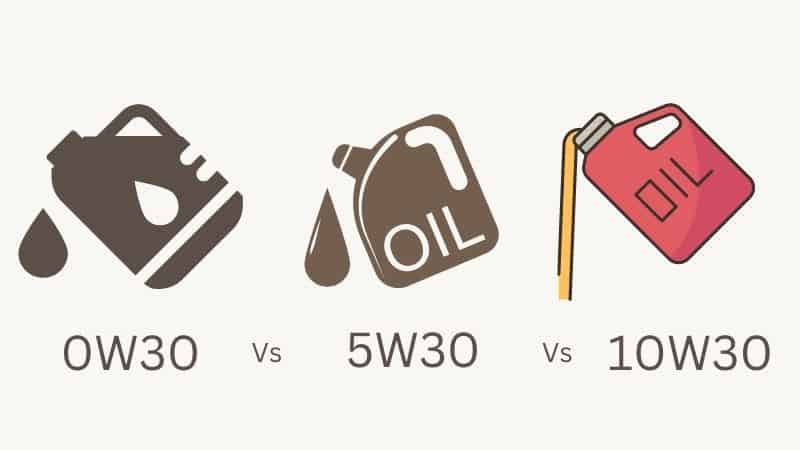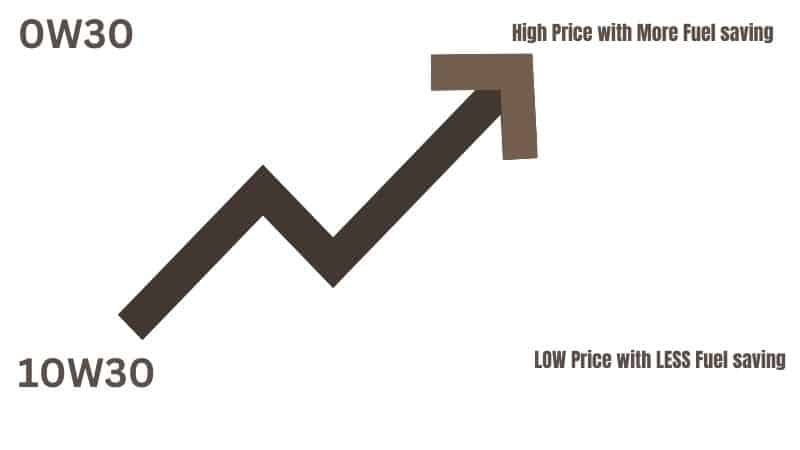When it comes to engine oil, there are so many options to choose from that it can be overwhelming. 0w30, 5w30, and 10w30 are some of the most popular options on the market. But what’s the difference between them and which one is better to choose?
Though there aren’t major differences between these three oils. Mainly it’s up to people’s personal preference which they would like to use.
In this article, we’ll try to highlight the comparison between 0w30 VS 5w30 VS 10w30 and know which you should pick out of them. So, keep reading this article.

A Comparison between 0w30 VS 5w30 VS 10w30
When it comes to motor oil, there can be a lot of confusion about the differences between 0w30, 5w30, and 10w30. All three are multi-grade oils, meaning that they are designed to perform in a wide range of temperatures.
However, there are subtle differences between each type of oil, and it’s important to understand these differences to make the best decision for your vehicle. Check the differences between 0w30, 5w30, and 10w30 motor oil.
Viscosity
Viscosity is a measuring unit of how thick or thin a fluid is. The higher the number, the thicker the oil. In cold weather, a thicker oil will flow more slowly than a thinner one, which is important for engines that start up easily in cold weather. Thinner oils are better for warm climates, where it’s less important for the oil to resist flowing quickly at high temperatures.
Read About: Viscosity Modifiers
0w30 is the thinnest of the three options, while 10w30 is the thickest. 5w30 falls in between these two options. This means that 0w30 is the best choice for cold climates, 5w30 is good for both cold and warm climates, and 10w30 should only be used in very hot climates.
Cold Start Performance
When it comes to 0w30 VS 5w30 VS 10w30, which one should you choose in terms of cold start performance?
For cold start performance, 0w30 is the best option. It has the thinnest oil film at startup and can flow more easily than the other two options. This means your engine will get up and running faster, with less wear and tear on the moving parts.
Fuel Economy
What about fuel economy? This is an important factor for many drivers, and it’s no different when it comes to engine oil. So, which oil is the most fuel-efficient?
0w30 is the clear winner in this category. It’s able to provide better fuel economy than both the 5w30 and 10w30. How much of a difference does this make?
In general, you can expect to see an improvement of up to 1.5% when using 0w30 instead of 10w30. This might not seem like a lot, but it can add up over time. And with today’s high gas prices, every little bit helps.
High Temperature
When it comes to the high-temperature performance of 0w30, 5w30, and 10w30 engine oils, you’ll find that 10w30 has the highest viscosity at high temperatures. This makes it more resistant to breakdown under extreme heat, which makes it a better choice for hotter climates and high-performance engines.
The 0w30 and 5w30 are both thinner and will provide better fuel economy due to their lower viscosities. However, they can break down more quickly under extreme heat. For this reason, you may have to change your oil more frequently if you live in a hotter climate or use your engine for intensive tasks.
In terms of wear protection, all three variants provide excellent protection when used within the appropriate range for their viscosity. The trick is to choose the right one for your specific needs and climate since too thin of oil can result in inadequate lubrication, while too thick of oil can reduce fuel economy.
Oil Change Intervals
Now another important fact is oil change intervals. Usually, 0W30 has a longer oil change interval than other oils like 5W30 and 10W30. This is because of its increased viscosity and ability to withstand higher temperatures.
0W30 can usually go a few thousand miles before needing an oil change. But that doesn’t mean you should wait that long—it all depends on how often you drive and how hard you use your vehicle. If you do a lot of towing or live in a hot climate, you might want to get the oil changed sooner than later.
For 5W30 and 10W30 oils, the recommended oil change interval is 3,000 miles or 3 months — whichever comes first. As long as you stick to this schedule, your engine will stay lubricated and your car will stay healthy overall.
Compatibility
In terms of compatibility, one important factor to consider is the mix of the oils. It is important to ensure that different types of oil can be combined without altering their performance. It is also recommended that you consult your car manual or contact the manufacturer before mixing oils. This will help you determine what type of oil works best for your engine type and whether any combination of oils could void the manufacturer’s warranty.
Another feature to consider for compatible installation is choosing synthetic or conventional oil bases. Synthetic oil bases are generally preferred because they have lower viscosities, superior detergents, and higher performance temperatures than regular motor oil, making them ideal for extreme weather conditions. Additionally, synthetic oils are engineered to resist thermal breakdown and oxidation more effectively than other types of oils, helping them last longer than regular motor oil.
Finally, it’s a good idea to check the manufacturer’s recommendation on what oil viscosity grade fits your engine best and try not to deviate from it when choosing an oil type and grade. In other words, if your engine requires 5W-30 motor oil then only use 5W-30 motor oil in your vehicle – no matter which brand or manufacturer you choose!
Price
So you’ve weighed all the benefits and drawbacks, but the price is still important when choosing which motor oil is right for your car.
It’s worth noting that 0W-30 will usually be the priciest option since it’s a more complex formulation designed to perform better in cold weather. But if you live in a region with cold winters, the extra price tag might be worth it. 5W-30 and 10W-30 are usually more affordable options, so they’re a great choice if you don’t experience extreme temperatures.
It’s also important to choose a motor oil that fits within your budget, especially if you plan on changing your oil often for maximum performance and protection. But be sure to compare prices between brands and check for discounts or promotions—you never know what you could find!

0w30 VS 5w30 VS 10w30- The Winner
Each oil has advantages and disadvantages so you’ll need to evaluate your needs before making a decision.
If you’re looking for better viscosity, then 0w30 is the best choice. For cold start performance, 5w30 is good because it thickens up quickly when conditions get cold. On the other hand, 10w30 gives you better high-temperature performance and fuel economy but it doesn’t perform as well in cold starts.
And don’t forget to factor in compatibility and price when making your decision as well. With all things considered, there isn’t one “best” oil that suits everyone – it depends on what your needs are and what type of car you drive!
Can I use 0w30 instead of 5w30
Using 0w30 instead of 5w30 can be a viable option in some circumstances. 0w30 is a synthetic oil that flows much better at low temperatures than 5w30. This can be beneficial in cold climates, as it will help to ensure that the oil can flow freely and lubricate the engine’s components even in cold weather. It can also be beneficial in high-performance engines, as it will provide better protection against wear and tear.
However, 0w30 is not suitable for all engines. It is only recommended for engines that are designed to use this oil, such as those with turbocharged or high-performance engines. Check with your manufacturer to see if 0w30 is appropriate for your vehicle.
Ultimately, the choice between 0w30 and 5w30 is a personal one. If you live in a cold climate and have a turbocharged or high-performance engine, then 0w30 may be a better option for you. However, if you have a conventional engine, then the 5w30 is probably the best choice.
Read Also: Can I Use 0w20 instead of 5w20?

FAQs
Q. Can I use 5w30 in hot weather?
Yes, you can use 5w30 in hot weather. Many modern motor oils are designed to perform well in a variety of temperatures and 5w30 is one of them. 5w30 is a multi-grade oil that is suitable for use in most modern engines. It can provide good protection in hot weather and help extend your engine’s life.
Q. What is the difference between 10w30 and 5w30 oil?
The primary difference between 10w30 VS 5w30 oil is their viscosity. 10w30 oil is thicker and designed for use in higher temperatures and heavier engine loads. 5w30 oil, on the other hand, is thinner and designed for use in colder temperatures and lighter engine loads. Both oils are formulated to protect against wear and tear on engine components.
Q. What happens if I use 10w40 instead of 5w30?
If you use 10w40 instead of 5w30, it may cause your engine to overwork and become less efficient. The thicker 10w40 oil can create more resistance and put a strain on the motor, which can lead to poor performance, increased fuel consumption, and damage to the engine over time. It is important to always use the oil recommended by the manufacturer to ensure the best performance and longevity of your engine.
Q. which is thicker 10w30 or 5w30?
In an oil grade, we know the first part containing W indicates the winter conditions and the second part means the viscosity. Viscosity depends on the thickness of the oil. so higher viscosity means higher thickness. But here we see that 5w30 and 10w30 both oils have the same viscosity of 30. So both oils have the almost same thickness in normal temperatures. But in the case of winter conditions, 10w30 will more thicker than 5w30.
Read: Thickest Motor Oil
Q. What are the differences between 0w30 Vs. 10w30?
The main difference between 0w30 and 10w30 is the viscosity. 0w30 is a low-viscosity oil that flows more easily and quickly through the engine. 10w30 is a higher viscosity oil, meaning it flows more slowly and is better able to lubricate the engine at higher temperatures.
Read: Difference Between 0w30 Vs 0w40
Conclusion
When it comes to 0w30, 5w30, and 10w30, each has its own set of benefits and drawbacks. 0w30 provides the best fuel economy and high-temperature performance, while 5w30 offers the best cold-start performance.
10w30 is a good middle ground, offering good performance in all areas while still maintaining compatibility and a reasonable price.
